Abstract
1. In mucosa-free preparations of the detrusor muscle electrical stimulation with 0·1 msec pulses has been utilized to reveal the non-cholinergic nature of most, if not all, of the post-ganglionic motor neurones in the guinea-pig bladder.
2. The twitches elicited by 0·1 msec pulses were abolished by tetrodotoxin, but were not reduced by dimethyltubocurarine or by hexamethonium. Hexamethonium was nevertheless present in all the experiments in order to restrict acetylcholine action to `muscarinic' receptors in the muscle fibres.
3. There was little or no diminution in the twitches after prolonged exposure to atropine, 10-8-10-5 g/ml., although the twitch-matching dose of acetylcholine was raised 1000-2500 times. Hence, there was no anomalous refractoriness to atropine in these `muscarinic' receptors.
4. Despite massive atropinization, the recruitment of unoccupied transmitter-receptors by means of extra pulses remained unaffected.
5. Eserine failed to potentiate the atropine-resistant twitches.
6. The twitches were not depressed by morphine.
7. Noradrenaline produced relaxation and twitch reduction. The twitches persisted after α + β adrenoceptor blockade with phentolamine + pronethalol and were unaffected by the monoamine oxidase and catecholamine-O-methyl transferase inhibitors, tranylcypromine and pyrogallol.
8. Rapid contractions were elicited by 5-HT and by histamine but the twitches remained unaltered after antagonism of 5-HT by methysergide and of histamine by mepyramine.
9. The twitches could be mimicked by injections of ATP, but after desensitization of the preparation to ATP the response to electrical stimulation remained unaltered.
10. Prostaglandins E2 and F2α, only in large doses, produced delayed, sluggish contractions which persisted after the wash; these contractions were quite different from the responses to electrical stimulation, which were immediate, sharp and brief.
11. The non-cholinergic nature of the post-ganglionic motor neurones was confirmed in the bladder of two other species, the cat and the rabbit.
Full text
PDF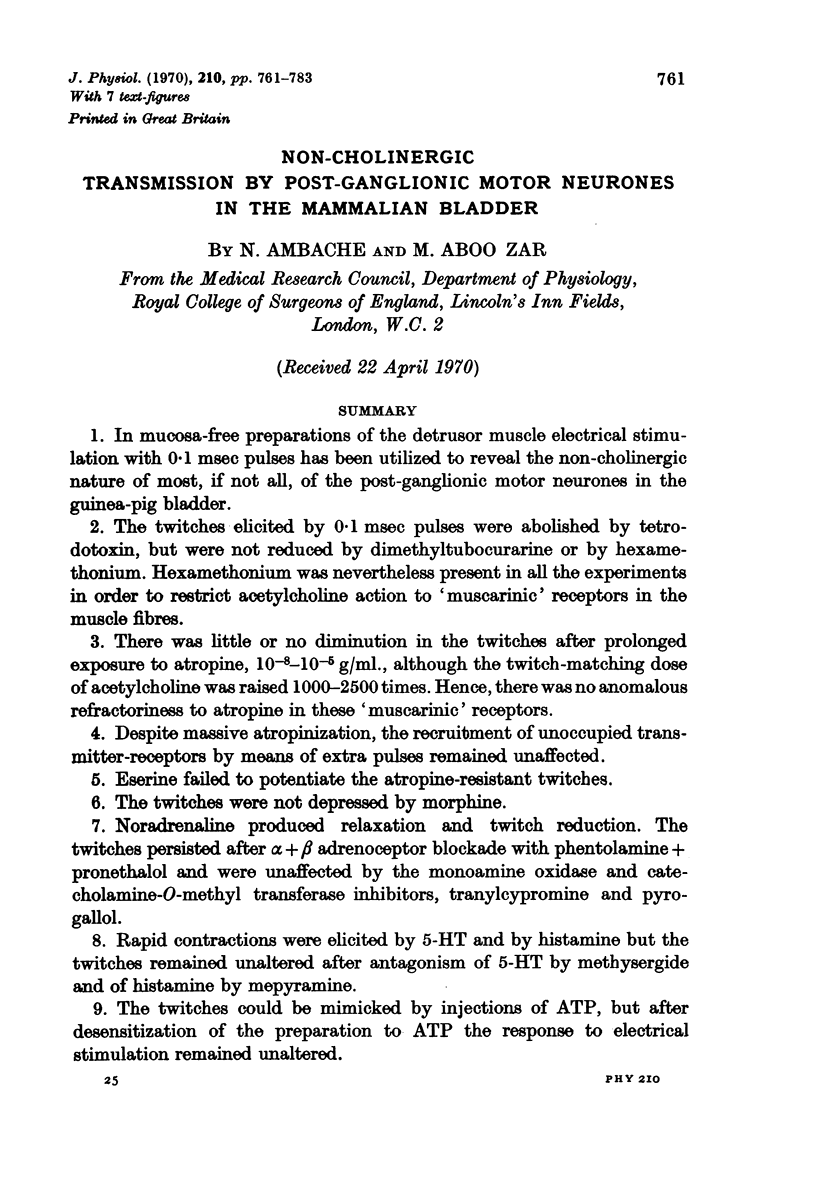
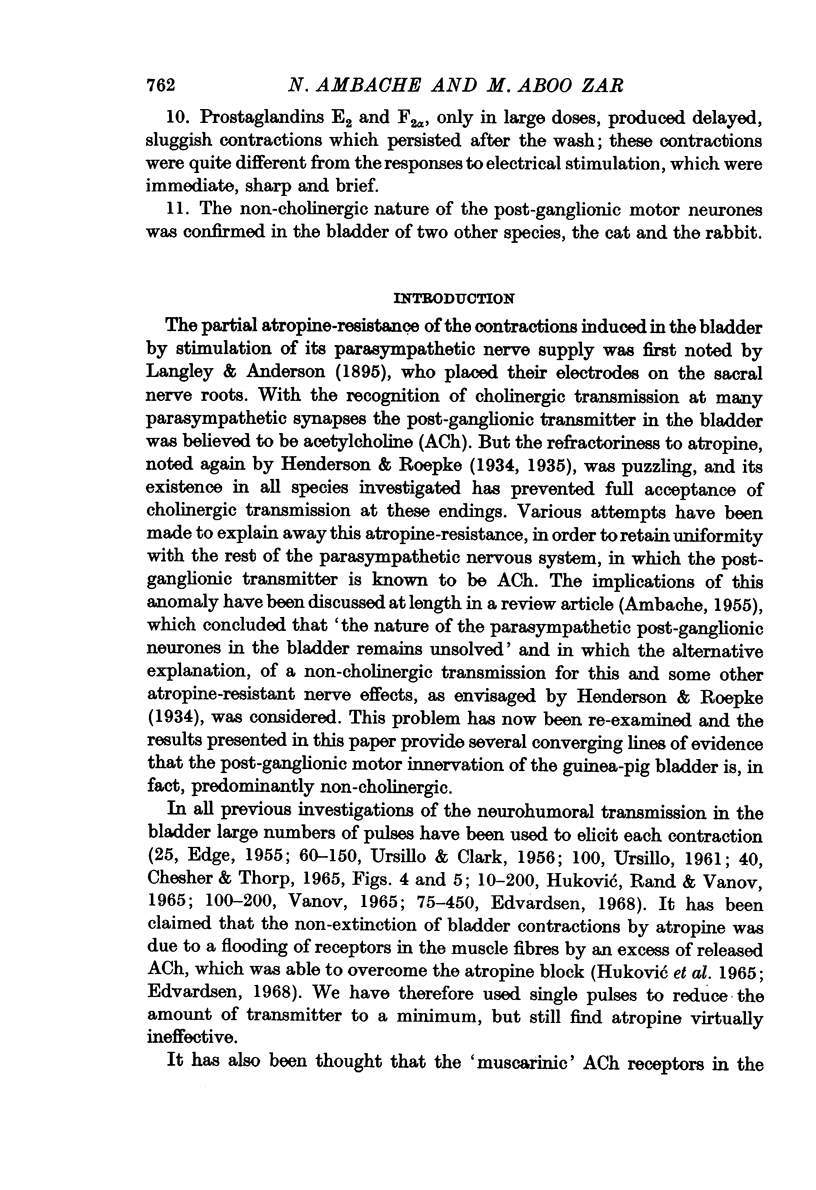
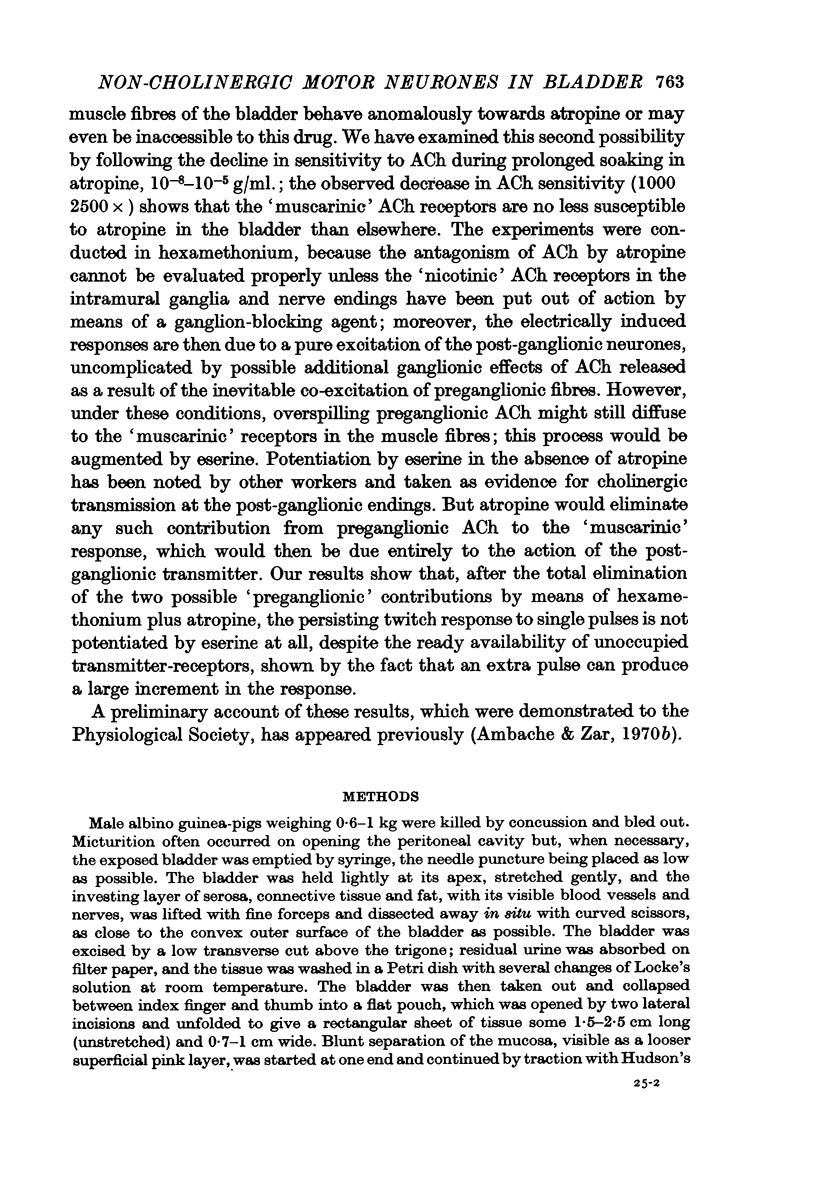
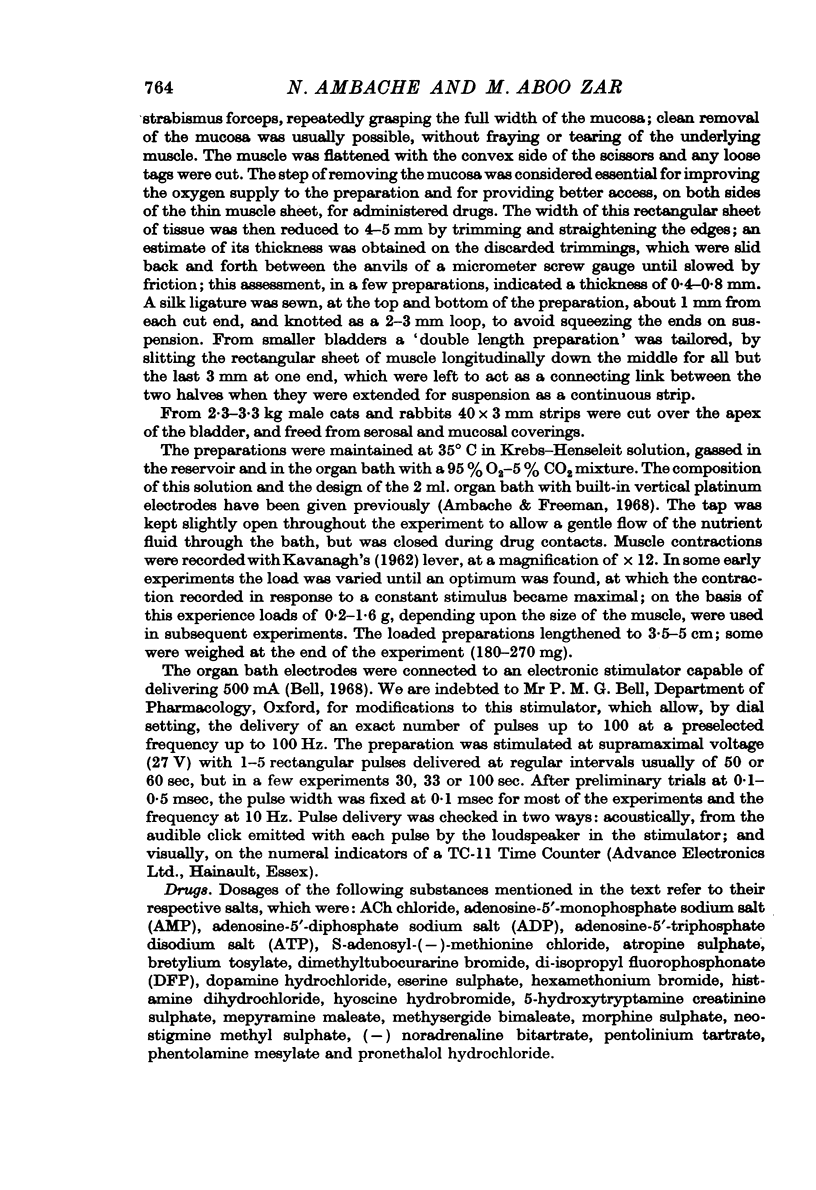
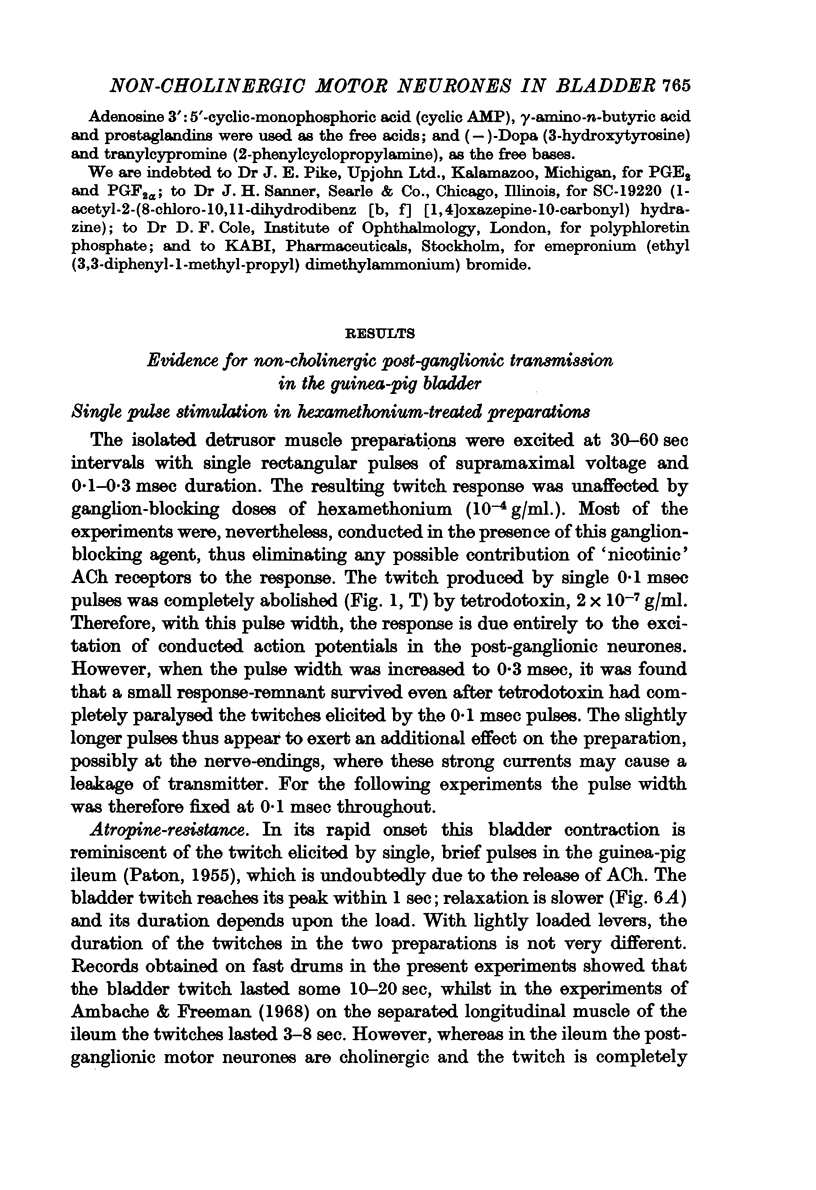
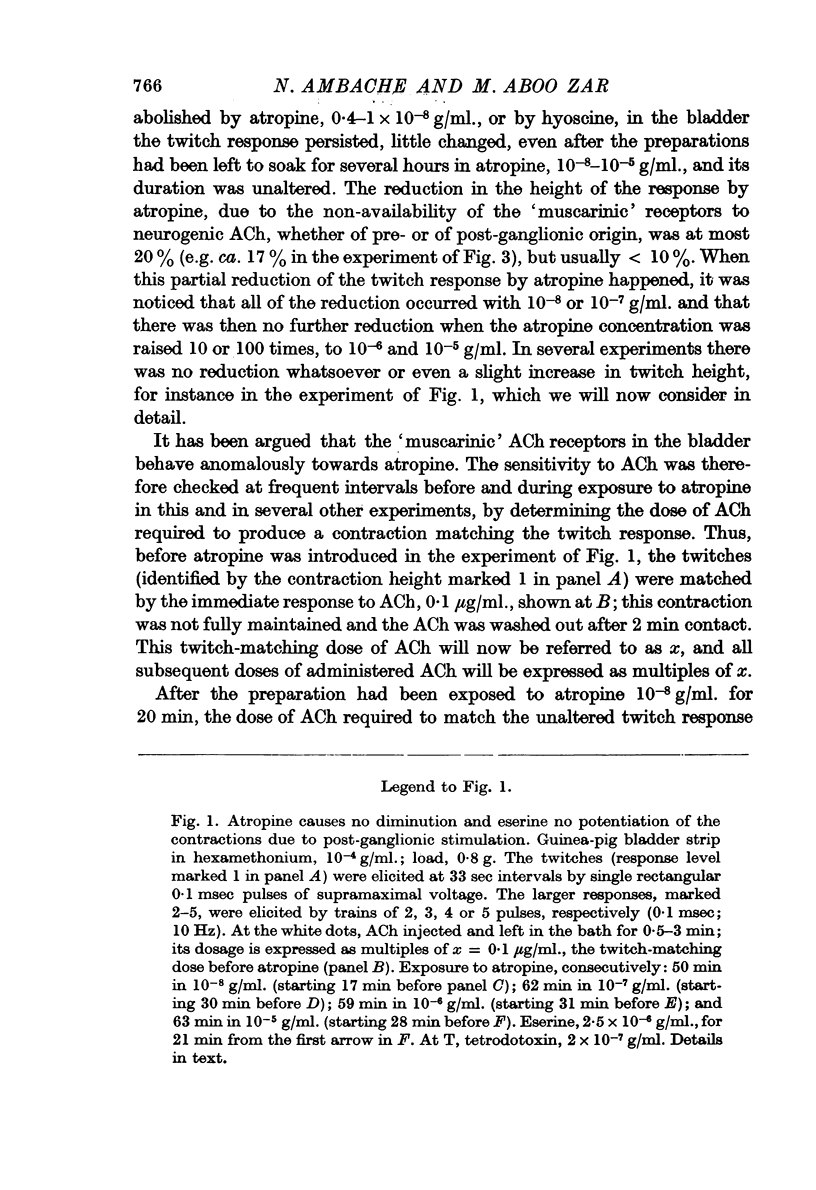
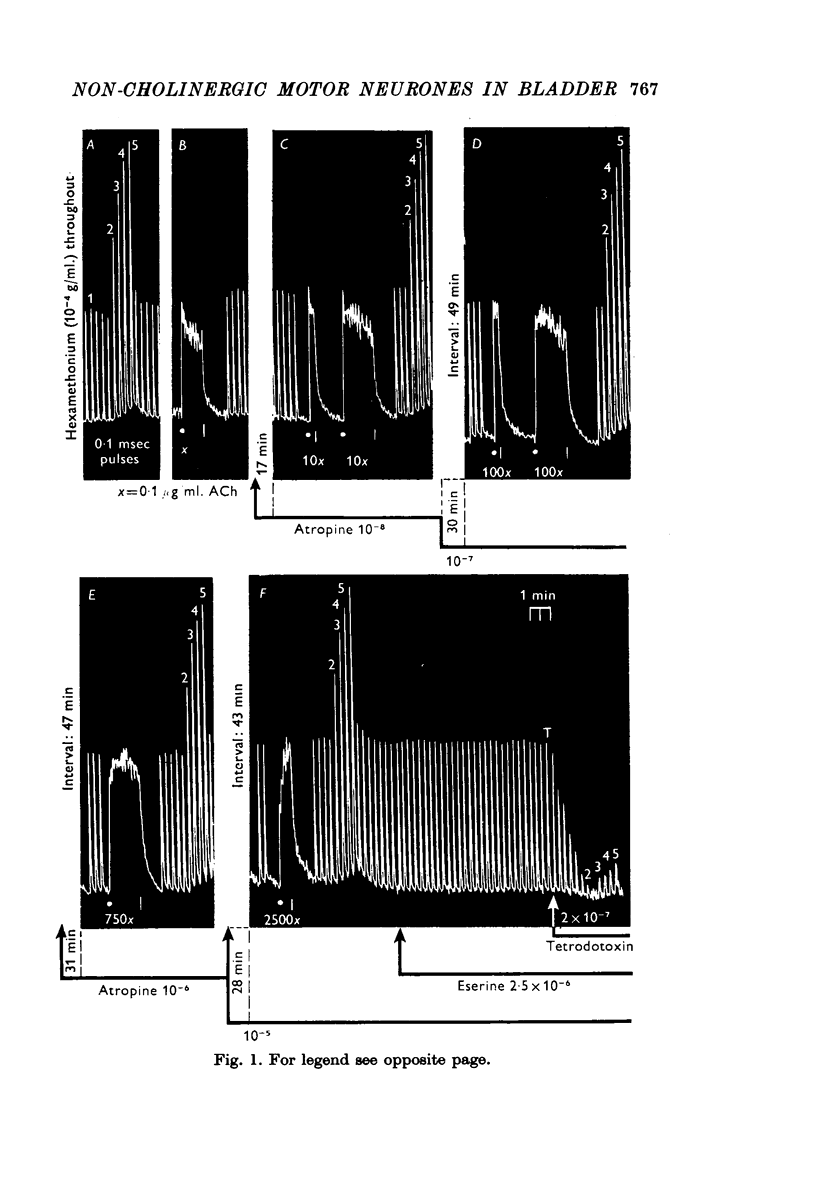
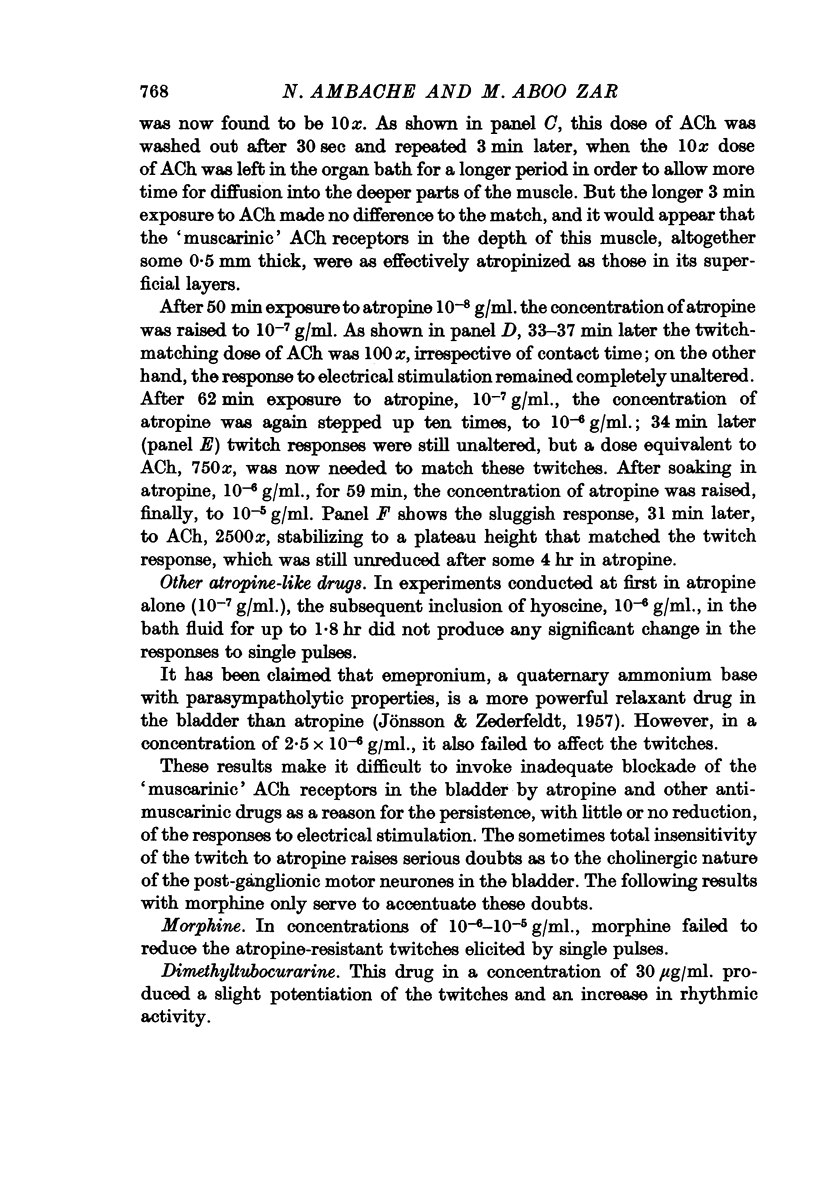
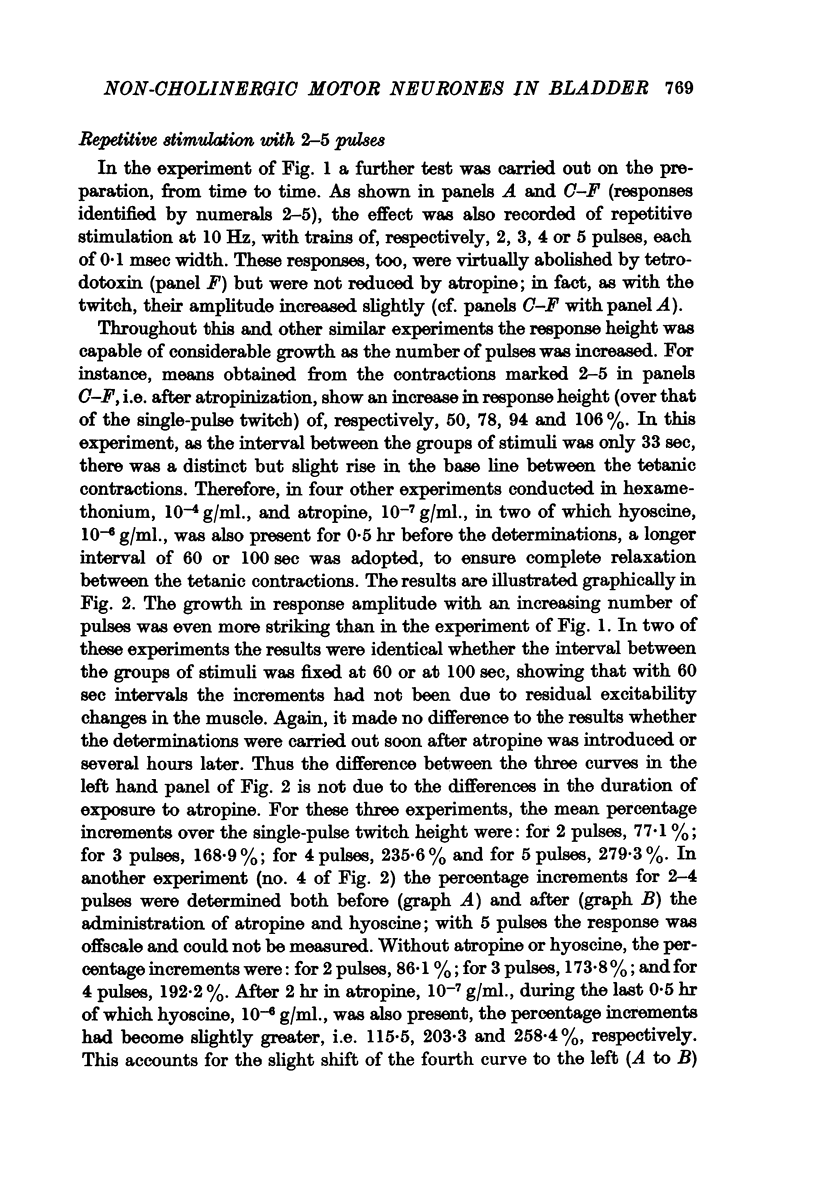
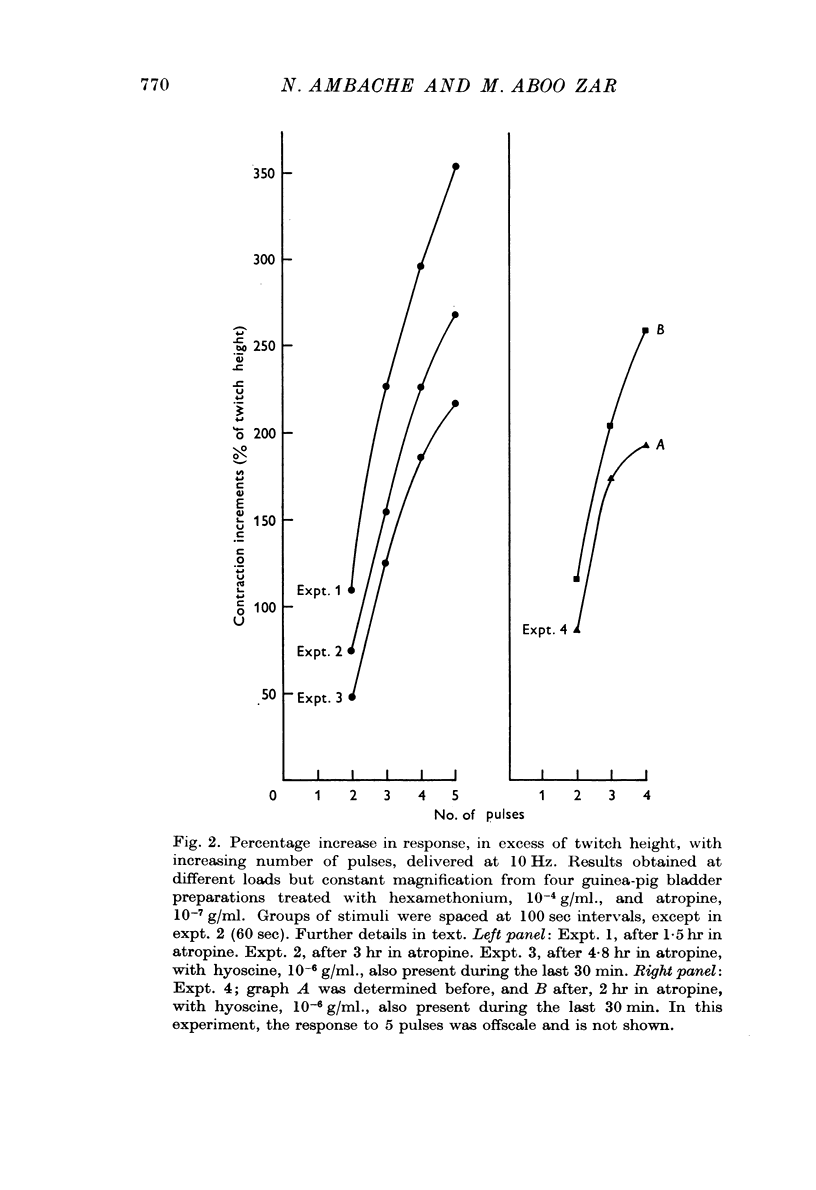
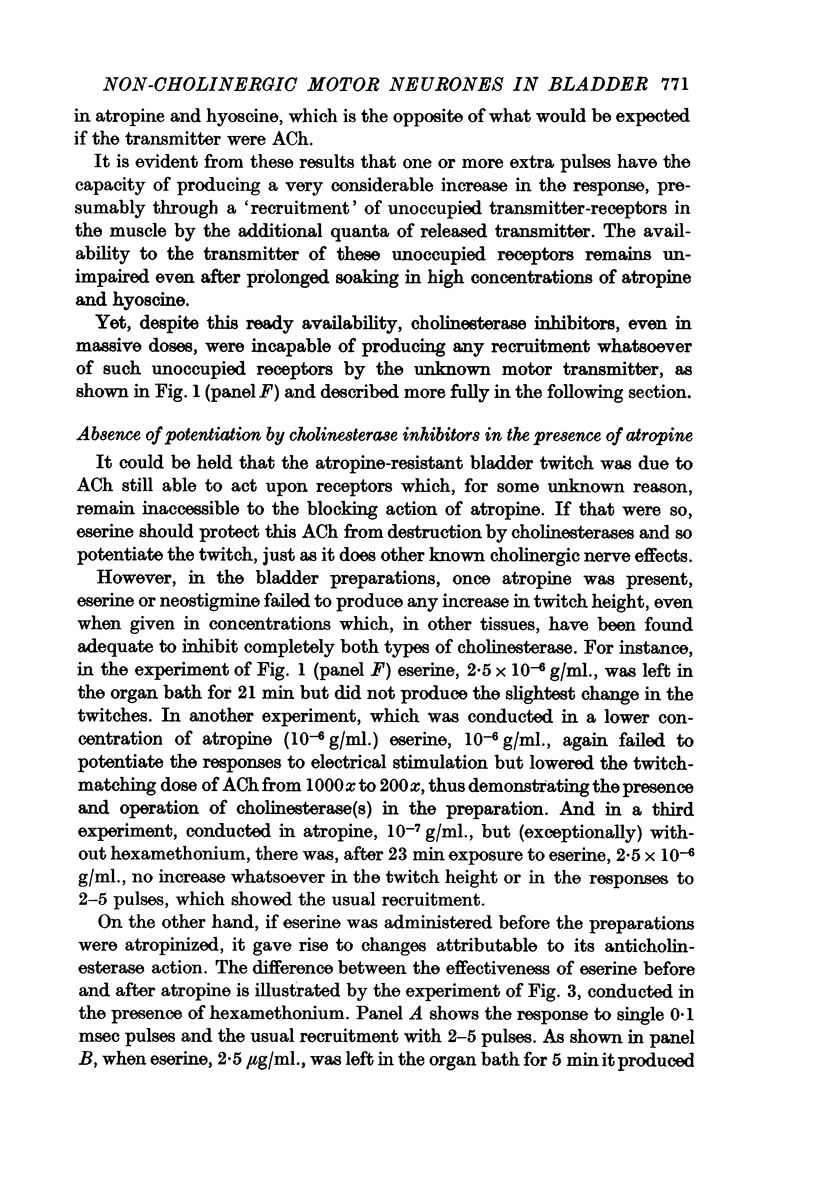
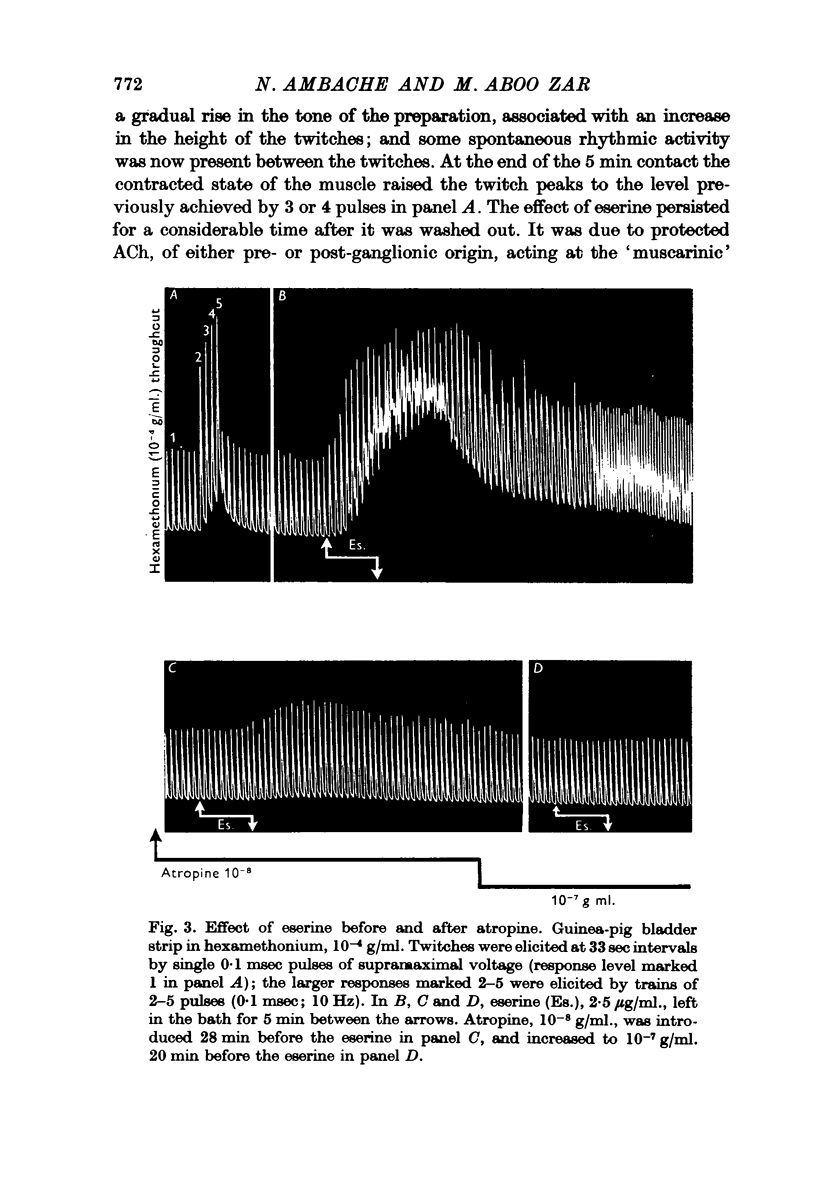
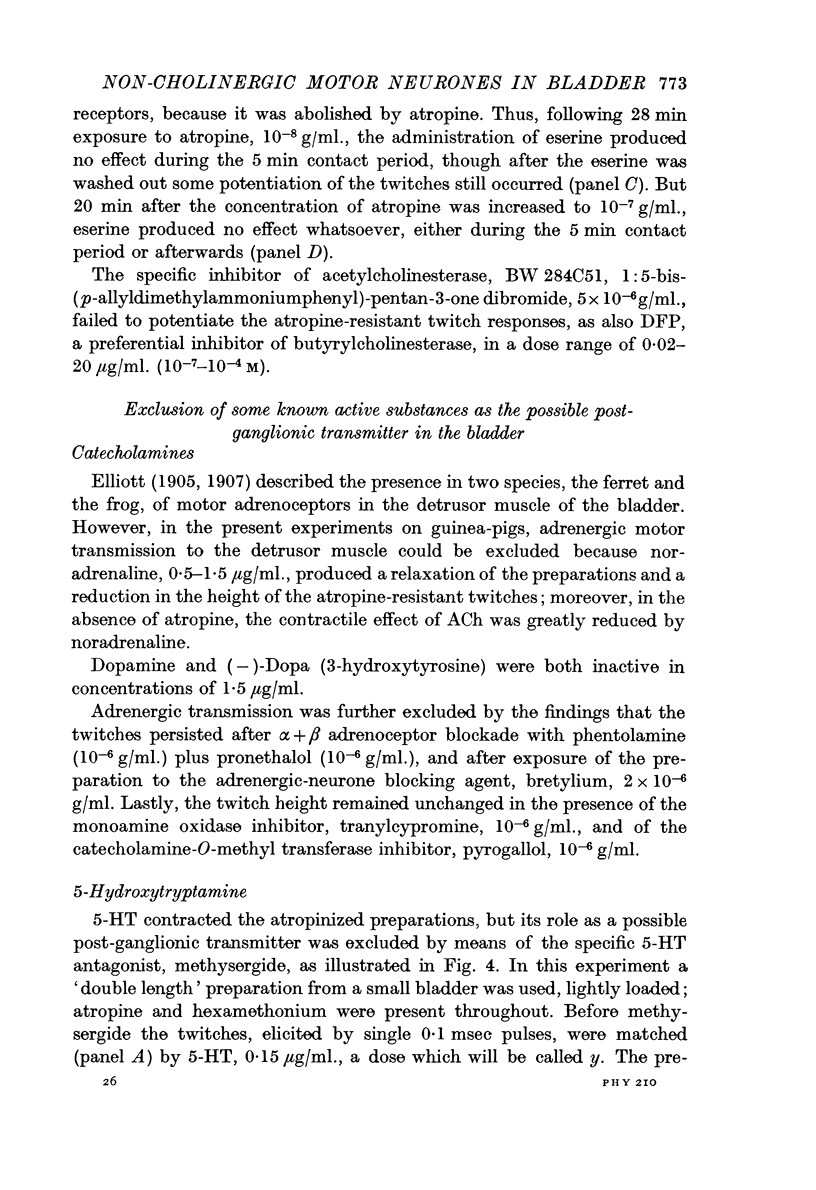
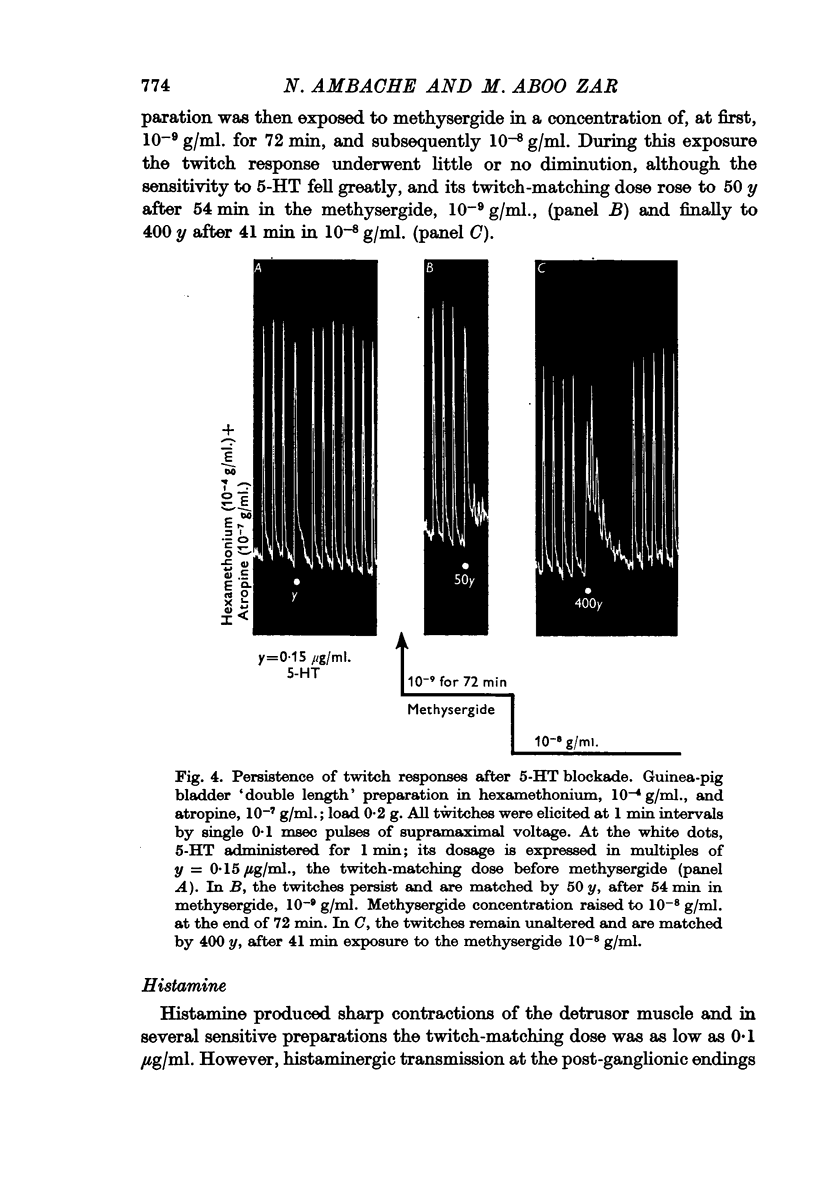
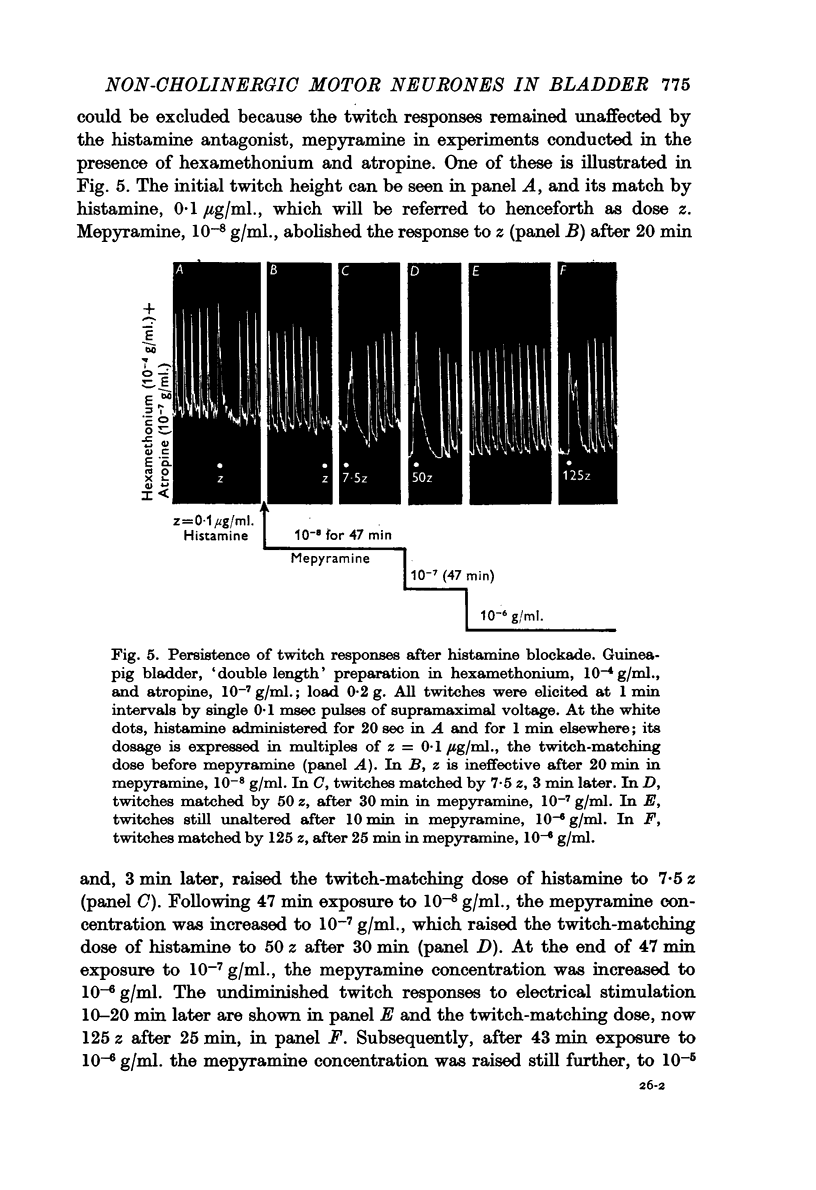
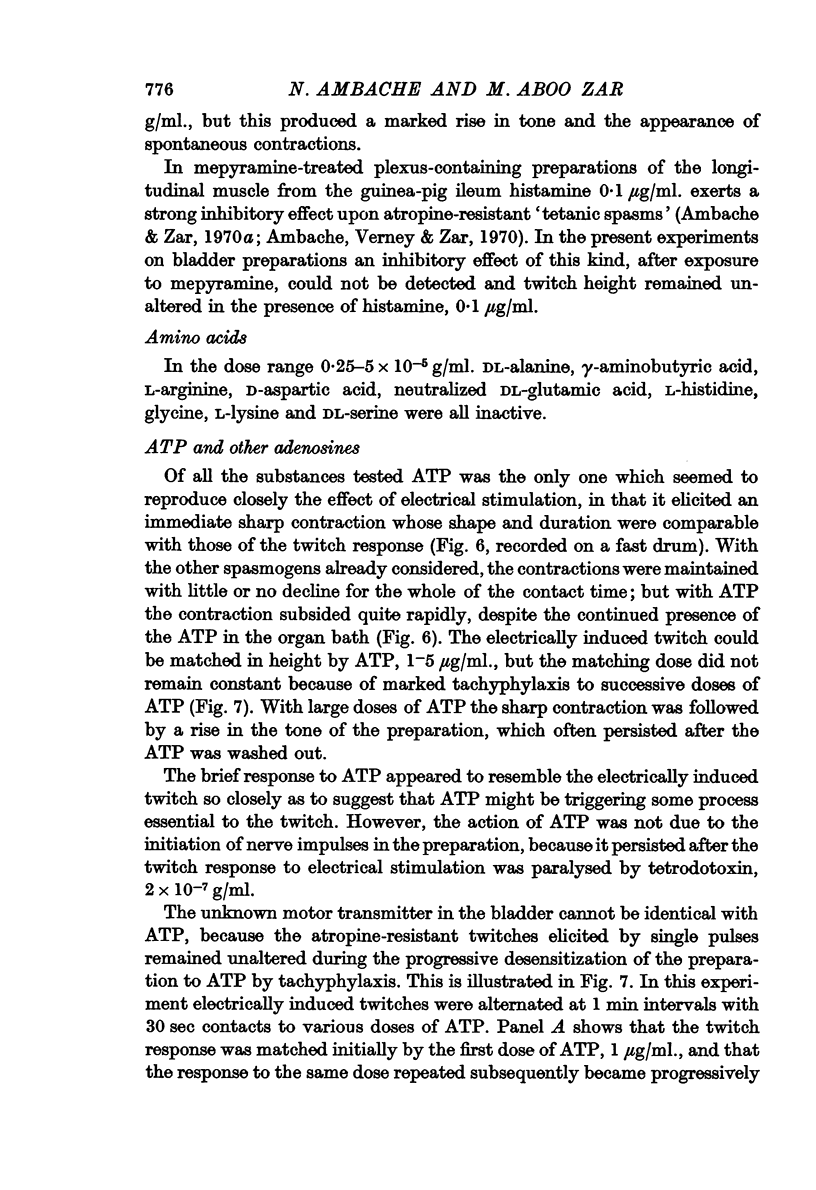
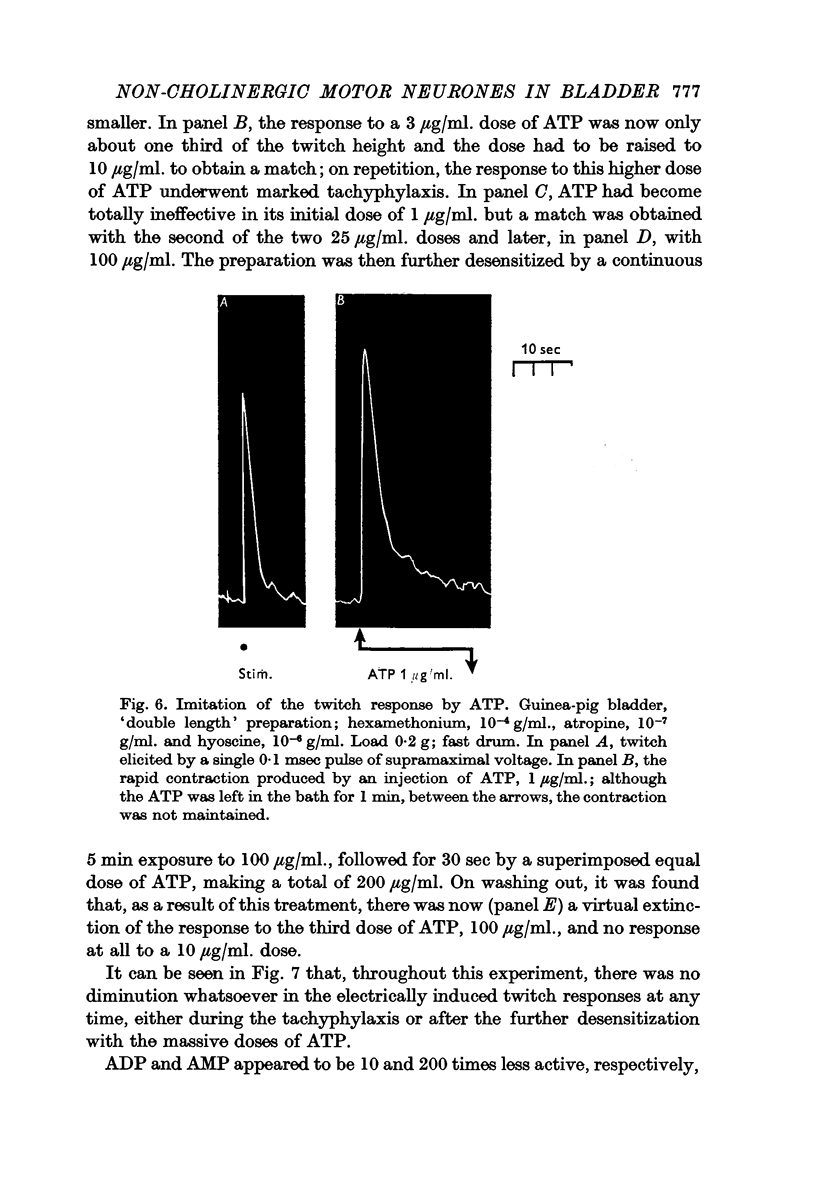
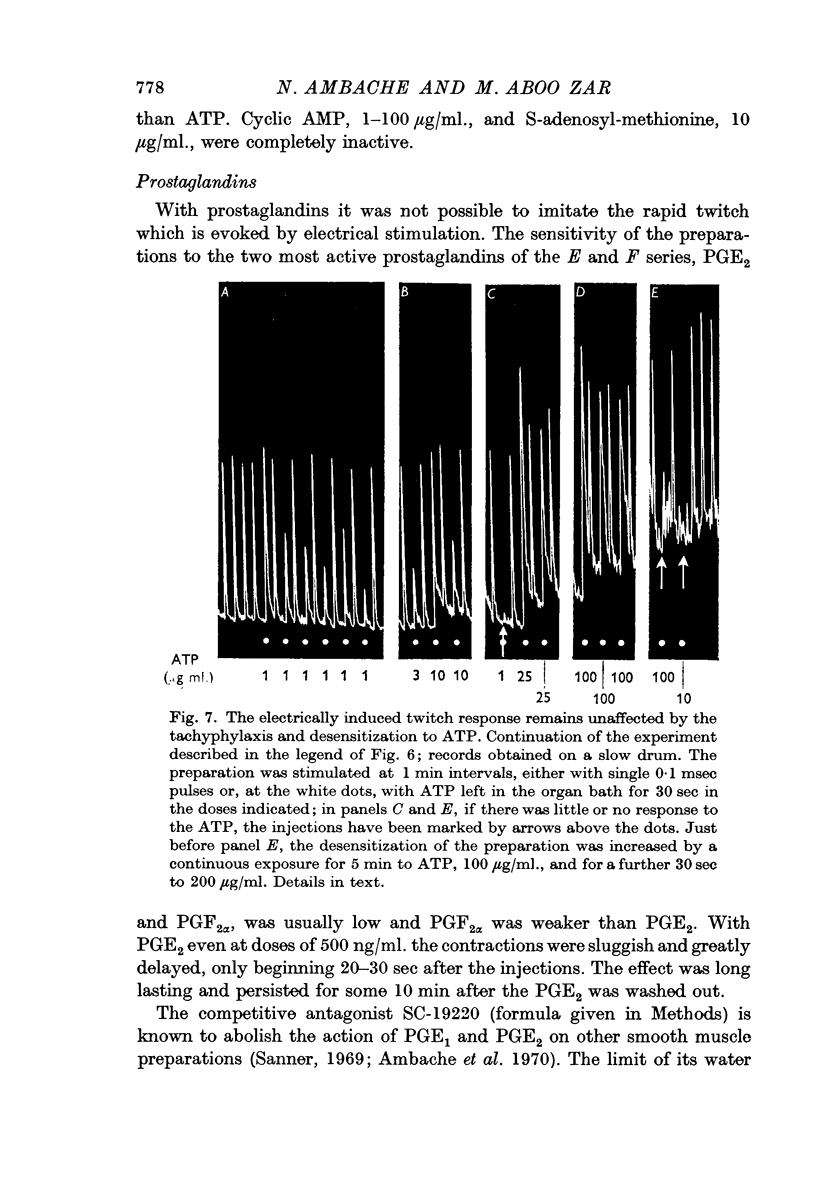
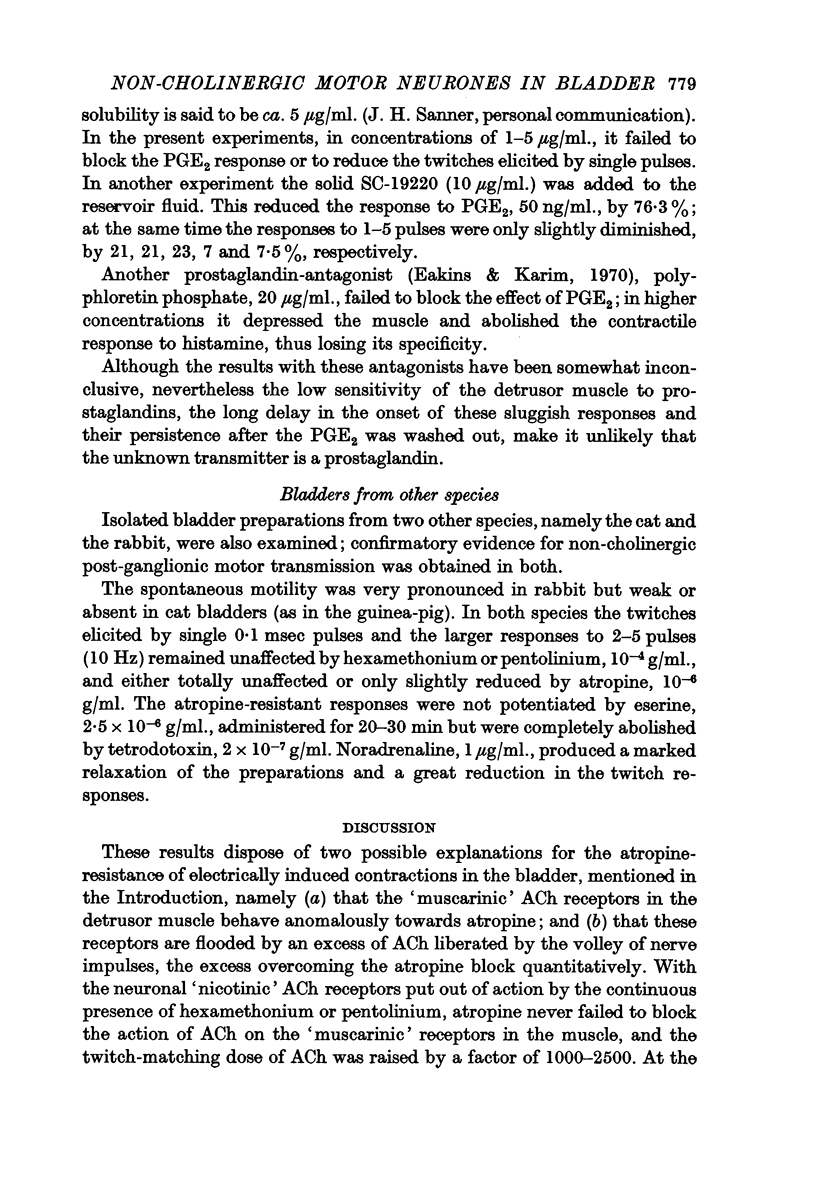
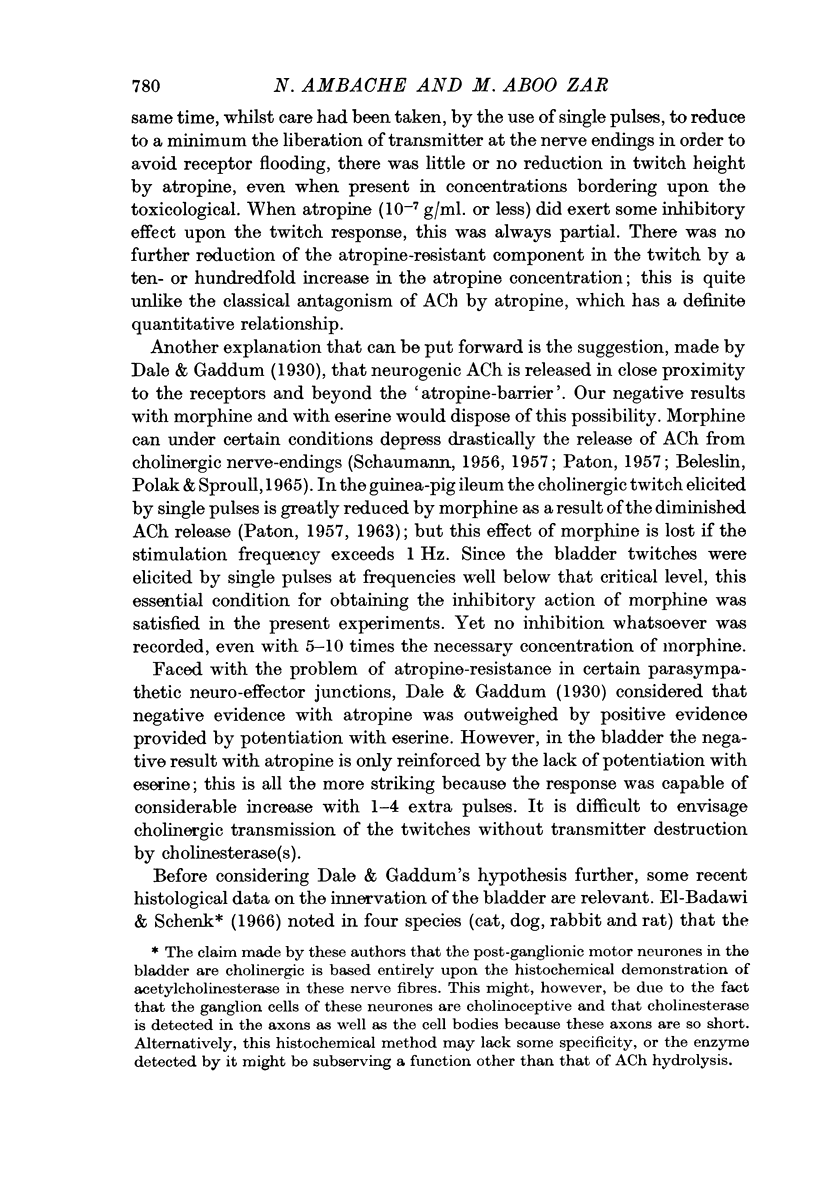
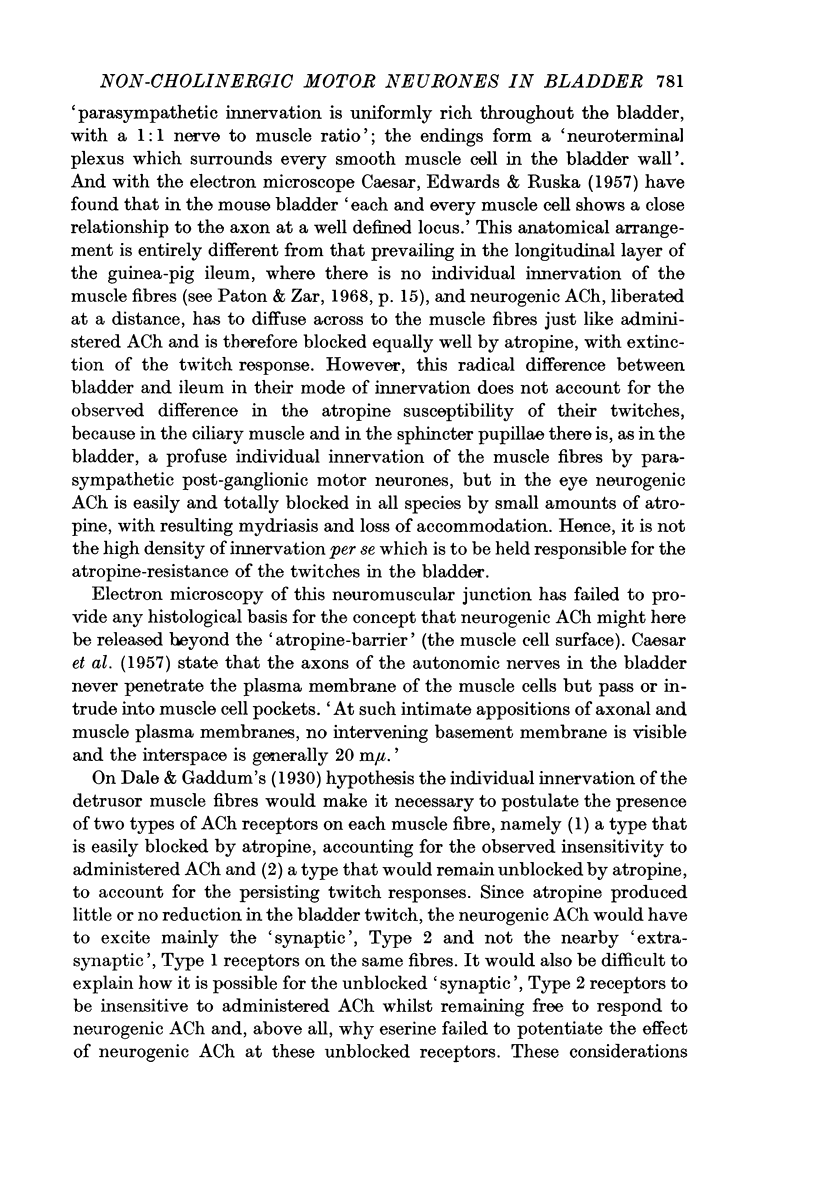
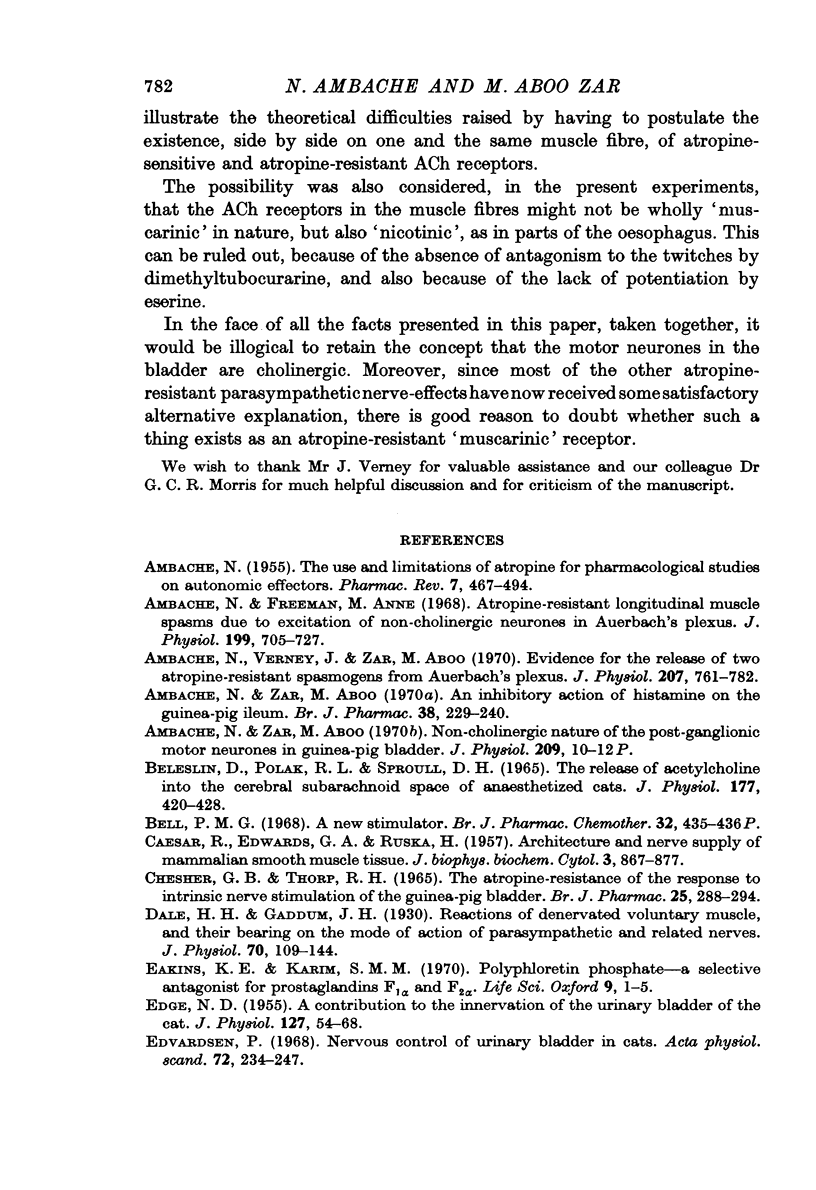
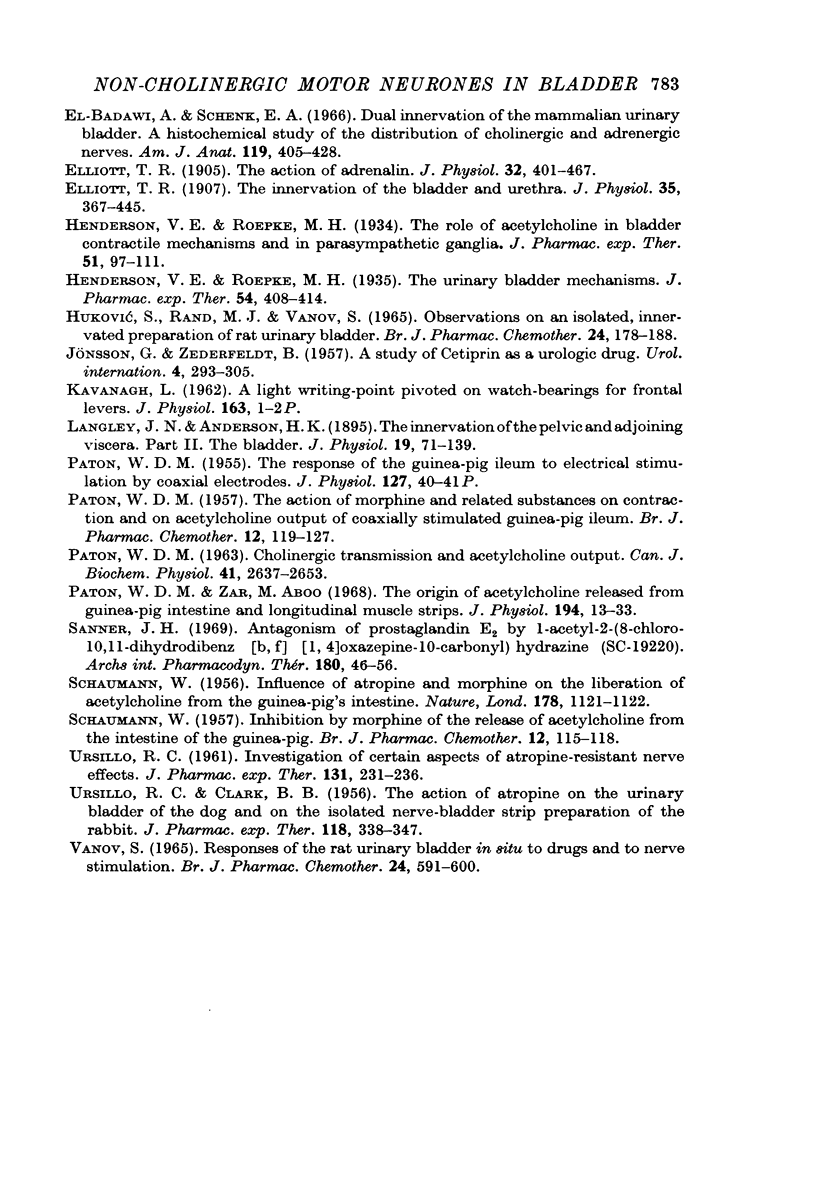
Selected References
These references are in PubMed. This may not be the complete list of references from this article.
- AMBACHE N. The use and limitations of atropine for pharmacological studies on autonomic effectors. Pharmacol Rev. 1955 Dec;7(4):467–494. [PubMed] [Google Scholar]
- Ambache N., Freeman M. A. Atropine-resistant longitudinal muscle spasms due to excitation of non-cholinergic neurones in Auerbach's plexus. J Physiol. 1968 Dec;199(3):705–727. doi: 10.1113/jphysiol.1968.sp008674. [DOI] [PMC free article] [PubMed] [Google Scholar]
- Ambache N., Verney J., Zar M. A. Evidence for the release of two atropine-resistant spasmogens from Auerbach's plexus. J Physiol. 1970 May;207(3):761–782. doi: 10.1113/jphysiol.1970.sp009093. [DOI] [PMC free article] [PubMed] [Google Scholar]
- Ambache N., Zar M. A. An inhibitory action of histamine on the guinea-pig ileum. Br J Pharmacol. 1970 Jan;38(1):229–240. doi: 10.1111/j.1476-5381.1970.tb10352.x. [DOI] [PMC free article] [PubMed] [Google Scholar]
- BELESLIN D., POLAK R. L., SPROULL D. H. THE RELEASE OF ACETYLCHOLINE INTO THE CEREBRAL SUBARACHNOID SPACE OF ANAESTHETIZED CATS. J Physiol. 1965 Apr;177:420–428. doi: 10.1113/jphysiol.1965.sp007601. [DOI] [PMC free article] [PubMed] [Google Scholar]
- CAESAR R., EDWARDS G. A., RUSKA H. Architecture and nerve supply of mammalian smooth muscle tissue. J Biophys Biochem Cytol. 1957 Nov 25;3(6):867–878. doi: 10.1083/jcb.3.6.867. [DOI] [PMC free article] [PubMed] [Google Scholar]
- CLARK B. B., URSILLO R. C. The action of atropine on the urinary bladder of the dog and on the isolated nerve-bladder strip preparation of the rabbit. J Pharmacol Exp Ther. 1956 Nov;118(3):338–347. [PubMed] [Google Scholar]
- Chesher G. B., Thorp R. H. The atropine-resistance of the response to intrinsic nerve stimulation of the guinea-pig bladder. Br J Pharmacol Chemother. 1965 Oct;25(2):288–294. doi: 10.1111/j.1476-5381.1965.tb02049.x. [DOI] [PMC free article] [PubMed] [Google Scholar]
- Dale H. H., Gaddum J. H. Reactions of denervated voluntary muscle, and their bearing on the mode of action of parasympathetic and related nerves. J Physiol. 1930 Sep 18;70(2):109–144. doi: 10.1113/jphysiol.1930.sp002682. [DOI] [PMC free article] [PubMed] [Google Scholar]
- EDGE N. D. A contribution to the innervation of the urinary bladder of the cat. J Physiol. 1955 Jan 28;127(1):54–68. doi: 10.1113/jphysiol.1955.sp005237. [DOI] [PMC free article] [PubMed] [Google Scholar]
- Eakins K. E., Karim S. M. Polyphloretin phosphate - a selective antagonist for prostaglandins F1 alpha and F2 alpha. Life Sci. 1970 Jan 1;9(1):1–5. doi: 10.1016/0024-3205(70)90002-0. [DOI] [PubMed] [Google Scholar]
- Edvardsen P. Nervous control of urinary bladder in cats. IV. Effects of autonomic blocking agents on responses to peripheral nerve stimulation. Acta Physiol Scand. 1968 Jan-Feb;72(1):234–247. doi: 10.1111/j.1748-1716.1968.tb03845.x. [DOI] [PubMed] [Google Scholar]
- Elliott T. R. The action of adrenalin. J Physiol. 1905 Jul 13;32(5-6):401–467. doi: 10.1113/jphysiol.1905.sp001093. [DOI] [PMC free article] [PubMed] [Google Scholar]
- Elliott T. R. The innervation of the bladder and urethra. J Physiol. 1907 Jul 2;35(5-6):367–445. doi: 10.1113/jphysiol.1907.sp001198. [DOI] [PMC free article] [PubMed] [Google Scholar]
- HUKOVIC S., RAND M. J., VANOV S. OBSERVATIONS ON AN ISOLATED, INNERVATED PREPARATION OF RAT URINARY BLADDER. Br J Pharmacol Chemother. 1965 Feb;24:178–188. doi: 10.1111/j.1476-5381.1965.tb02093.x. [DOI] [PMC free article] [PubMed] [Google Scholar]
- JONSSON G., ZEDERFELDT B. A study of cetiprin as a urologic drug. Urol Int. 1957;4(5):293–305. doi: 10.1159/000277270. [DOI] [PubMed] [Google Scholar]
- Langley J. N., Anderson H. K. The Innervation of the Pelvic and adjoining Viscera: Part II. The Bladder. Part III. The External Generative Organs. Part IV. The Internal Generative Organs. Part V. Position of the Nerve Cells on the Course of the Efferent Nerve Fibres. J Physiol. 1895 Dec 30;19(1-2):71–139. doi: 10.1113/jphysiol.1895.sp000587. [DOI] [PMC free article] [PubMed] [Google Scholar]
- PATON W. D. CHOLINERGIC TRANSMISSION AND ACETYLCHOLINE OUTPUT. Can J Biochem Physiol. 1963 Dec;41:2637–2653. [PubMed] [Google Scholar]
- PATON W. D. The action of morphine and related substances on contraction and on acetylcholine output of coaxially stimulated guinea-pig ileum. Br J Pharmacol Chemother. 1957 Mar;12(1):119–127. doi: 10.1111/j.1476-5381.1957.tb01373.x. [DOI] [PMC free article] [PubMed] [Google Scholar]
- PATON W. D. The response of the guineapig ileum to electrical stimulation by coaxial electrodes. J Physiol. 1955 Feb 28;127(2):40–1P. [PubMed] [Google Scholar]
- Paton W. D., Zar M. A. The origin of acetylcholine released from guinea-pig intestine and longitudinal muscle strips. J Physiol. 1968 Jan;194(1):13–33. doi: 10.1113/jphysiol.1968.sp008392. [DOI] [PMC free article] [PubMed] [Google Scholar]
- SCHAUMANN W. Influence of atropine and morphine on the liberation of acetylcholine from the guinea pig's intestine. Nature. 1956 Nov 17;178(4542):1121–1122. doi: 10.1038/1781121b0. [DOI] [PubMed] [Google Scholar]
- SCHAUMANN W. Inhibition by morphine of the release of acetylcholine from the intestine of the guinea-pig. Br J Pharmacol Chemother. 1957 Mar;12(1):115–118. doi: 10.1111/j.1476-5381.1957.tb01372.x. [DOI] [PMC free article] [PubMed] [Google Scholar]
- Sanner J. H. Antagonism of prostaglandin E2 by 1-acetyl-2-(8-chloro-10,11-dihydrodibenz (b,f) (1,4) oxazepine-10-carbonyl) hydrazine (SC-19220). Arch Int Pharmacodyn Ther. 1969 Jul;180(1):46–56. [PubMed] [Google Scholar]
- URSILLO R. C. Investigation of certain aspects of atropine-resistant nerve effects. J Pharmacol Exp Ther. 1961 Feb;131:231–236. [PubMed] [Google Scholar]
- VANOV S. RESPONSES OF THE RAT URINARY BLADDER IN SITU TO DRUGS AND TO NERVE STIMULATION. Br J Pharmacol Chemother. 1965 Apr;24:591–600. doi: 10.1111/j.1476-5381.1965.tb01750.x. [DOI] [PMC free article] [PubMed] [Google Scholar]
- el-Badawi A., Schenk E. A. Dual innervation of the mammalian urinary bladder. A histochemical study of the distribution of cholinergic and adrenergic nerves. Am J Anat. 1966 Nov;119(3):405–427. doi: 10.1002/aja.1001190305. [DOI] [PubMed] [Google Scholar]


